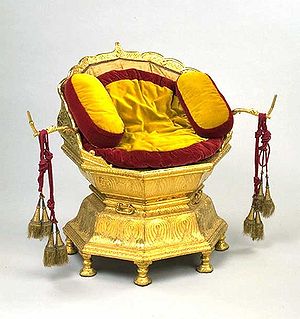Maharaja Ranjit Singh's throne
- Maharaja Ranjit Singh's throne
-

Maharaja Ranjit Singh's throne, ca 1820-1830, Hafiz Muhammad Multani V&A Museum no. 2518(IS)
Maharaja Ranjit Singh's throne was made by the goldsmith Hafez Muhammad Multani about 1820 to 1830. Made of Wood and resin core, covered with sheets of repoussé, chased and engraved gold.[1]
Overview
It shows the splendour of Ranjit Singh's court and is decorated with richly worked sheets of gold. The distinctive cusped base of this throne is composed of two tiers of lotus petals. The lotus is a symbol of purity and creation and has traditionally been used as a seat or throne for Hindu gods. However, the octagonal (eight-sided) shape of the throne is based on courtly furniture of the Mughals. Their many-sided furniture provided models for thrones, footstools and tables throughout northern India. It is thought that as the Maharaja was renowned for the simplicity of his appearance and dislike of ceremony he rarely sat on this throne, preferring to sit cross-legged on carpets.
The throne was part of the State Property taken by the British in 1849 on the annexation of Punjab, after the Second Anglo-Sikh War, and was displayed with other treasures of the Indian Empire at the Great Exhibition in 1851.
Bibliography
- Jackson, Anna (ed.) (2001). V&A: A Hundred Highlights. V&A Publications.
References
External links
Categories:
- Asian objects in the Victoria and Albert Museum
- Thrones
- Sikh Empire
Wikimedia Foundation.
2010.
Look at other dictionaries:
Ranjit Singh — For other uses, see Maharaja Ranjit Singh (disambiguation). Ranjit Singh Maharaja of Punjab Ranjit Singh Reign 12 April 1801 – 27 June 1839 … Wikipedia
Ranjit Singh of Bharatpur — For other uses, see Maharaja Ranjit Singh (disambiguation). Maharaja Ranjit Singh (Hindi: महाराजा रणजीत सिंह) was the ruling Maharaja of princely state Bharatpur (1776–1805) and successor of Maharaja Nawal Singh. Maharaja Jawahar Singh ruled from … Wikipedia
Ranjit Singh — /run jit sing /, ( Lion of the Punjab ) 1780 1839, Indian maharaja: founder of the Sikh kingdom of Punjab. * * * born Nov. 13, 1780, Budrukhan or Gujranwala, India died June 27, 1839, Lahore Founder and maharaja (1801–39) of the Sikh kingdom of… … Universalium
Throne — This article is about royal thrones; for other meanings see Throne (disambiguation). The thrones for Elizabeth II as Queen of Canada, and the Duke of Edinburgh (back) in the Canadian Senate, Ottawa are usually occupied by the Queen s… … Wikipedia
Maharaja — Maharani redirects here. For the music album, see Maharani (album). Maharaj redirects here. For the Indian bestselling author, see Rabi Maharaj … Wikipedia
Randhir Singh of Bharatpur — Maharaja Randhir Singh (Hindi: महाराजा रणधीर सिंह) (1805–1823) was the ruler of princely state Bharatpur and successor of Maharaja Ranjit Singh. Maharaja Randhir Singh ascended the throne after death of his father Maharaja Ranjit Singh in 1805.… … Wikipedia
Gulab Singh of Jammu and Kashmir — Gulab Singh (Dogri: गुलाब सिंह) (1792–1857) was the founder and first Maharaja of the princely state of Jammu and Kashmir, the second largest princely state in British India. After the defeat of the Sikhs in the First Anglo Sikh War, Gulab Singh … Wikipedia
Duleep Singh — This article is about Maharaja Dalip Singh. For other uses, see Dalip Singh Maharaja Dalip Singh Sukerchakia Maharajah Duleep Singh in ceremonial dress, 1861. Born 6 September 1838 Lahore, Sikh Empire D … Wikipedia
Nau Nihal Singh — Maharaja Nau Nihal Singh of the Sikh Empire. Born 9 March 1821 Died 6 November 1840 … Wikipedia
Banda Singh Bahadur — SikhiBaba Banda Singh Bahadur (1670 1716) (Lachhman Dev) was a Sikh warrior known for his struggle against the Mughal Empire in the early eighteenth century. The title Baba (Elder) in Sikhism denotes respect.Famous for the sack of the Mughal… … Wikipedia

